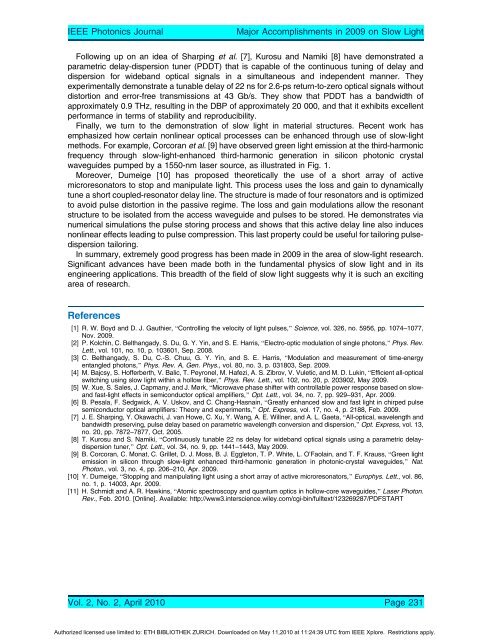Breakthroughs Breakthroughs - ETH - Ultrafast Laser Physics
Breakthroughs Breakthroughs - ETH - Ultrafast Laser Physics
Breakthroughs Breakthroughs - ETH - Ultrafast Laser Physics
You also want an ePaper? Increase the reach of your titles
YUMPU automatically turns print PDFs into web optimized ePapers that Google loves.
IEEE Photonics Journal Major Accomplishments in 2009 on Slow Light<br />
Following up on an idea of Sharping et al. [7], Kurosu and Namiki [8] have demonstrated a<br />
parametric delay-dispersion tuner (PDDT) that is capable of the continuous tuning of delay and<br />
dispersion for wideband optical signals in a simultaneous and independent manner. They<br />
experimentally demonstrate a tunable delay of 22 ns for 2.6-ps return-to-zero optical signals without<br />
distortion and error-free transmissions at 43 Gb/s. They show that PDDT has a bandwidth of<br />
approximately 0.9 THz, resulting in the DBP of approximately 20 000, and that it exhibits excellent<br />
performance in terms of stability and reproducibility.<br />
Finally, we turn to the demonstration of slow light in material structures. Recent work has<br />
emphasized how certain nonlinear optical processes can be enhanced through use of slow-light<br />
methods. For example, Corcoran et al. [9] have observed green light emission at the third-harmonic<br />
frequency through slow-light-enhanced third-harmonic generation in silicon photonic crystal<br />
waveguides pumped by a 1550-nm laser source, as illustrated in Fig. 1.<br />
Moreover, Dumeige [10] has proposed theoretically the use of a short array of active<br />
microresonators to stop and manipulate light. This process uses the loss and gain to dynamically<br />
tune a short coupled-resonator delay line. The structure is made of four resonators and is optimized<br />
to avoid pulse distortion in the passive regime. The loss and gain modulations allow the resonant<br />
structure to be isolated from the access waveguide and pulses to be stored. He demonstrates via<br />
numerical simulations the pulse storing process and shows that this active delay line also induces<br />
nonlinear effects leading to pulse compression. This last property could be useful for tailoring pulsedispersion<br />
tailoring.<br />
In summary, extremely good progress has been made in 2009 in the area of slow-light research.<br />
Significant advances have been made both in the fundamental physics of slow light and in its<br />
engineering applications. This breadth of the field of slow light suggests why it is such an exciting<br />
area of research.<br />
References<br />
[1] R. W. Boyd and D. J. Gauthier, BControlling the velocity of light pulses,[ Science, vol. 326, no. 5956, pp. 1074–1077,<br />
Nov. 2009.<br />
[2] P. Kolchin, C. Belthangady, S. Du, G. Y. Yin, and S. E. Harris, BElectro-optic modulation of single photons,[ Phys. Rev.<br />
Lett., vol. 101, no. 10, p. 103601, Sep. 2008.<br />
[3] C. Belthangady, S. Du, C.-S. Chuu, G. Y. Yin, and S. E. Harris, BModulation and measurement of time-energy<br />
entangled photons,[ Phys. Rev. A, Gen. Phys., vol. 80, no. 3, p. 031803, Sep. 2009.<br />
[4] M. Bajcsy, S. Hofferberth, V. Balic, T. Peyronel, M. Hafezi, A. S. Zibrov, V. Vuletic, and M. D. Lukin, BEfficient all-optical<br />
switching using slow light within a hollow fiber,[ Phys. Rev. Lett., vol. 102, no. 20, p. 203902, May 2009.<br />
[5] W. Xue, S. Sales, J. Capmany, and J. Mørk, BMicrowave phase shifter with controllable power response based on slowand<br />
fast-light effects in semiconductor optical amplifiers,[ Opt. Lett., vol. 34, no. 7, pp. 929–931, Apr. 2009.<br />
[6] B. Pesala, F. Sedgwick, A. V. Uskov, and C. Chang-Hasnain, BGreatly enhanced slow and fast light in chirped pulse<br />
semiconductor optical amplifiers: Theory and experiments,[ Opt. Express, vol. 17, no. 4, p. 2188, Feb. 2009.<br />
[7] J. E. Sharping, Y. Okawachi, J. van Howe, C. Xu, Y. Wang, A. E. Willner, and A. L. Gaeta, BAll-optical, wavelength and<br />
bandwidth preserving, pulse delay based on parametric wavelength conversion and dispersion,[ Opt. Express, vol. 13,<br />
no. 20, pp. 7872–7877, Oct. 2005.<br />
[8] T. Kurosu and S. Namiki, BContinuously tunable 22 ns delay for wideband optical signals using a parametric delaydispersion<br />
tuner,[ Opt. Lett., vol. 34, no. 9, pp. 1441–1443, May 2009.<br />
[9] B. Corcoran, C. Monat, C. Grillet, D. J. Moss, B. J. Eggleton, T. P. White, L. O’Faolain, and T. F. Krauss, BGreen light<br />
emission in silicon through slow-light enhanced third-harmonic generation in photonic-crystal waveguides,[ Nat.<br />
Photon., vol. 3, no. 4, pp. 206–210, Apr. 2009.<br />
[10] Y. Dumeige, BStopping and manipulating light using a short array of active microresonators,[ Europhys. Lett., vol. 86,<br />
no. 1, p. 14003, Apr. 2009.<br />
[11] H. Schmidt and A. R. Hawkins, BAtomic spectroscopy and quantum optics in hollow-core waveguides,[ <strong>Laser</strong> Photon.<br />
Rev., Feb. 2010. [Online]. Available: http://www3.interscience.wiley.com/cgi-bin/fulltext/123269287/PDFSTART.<br />
Vol. 2, No. 2, April 2010 Page 231<br />
Authorized licensed use limited to: <strong>ETH</strong> BIBLIOTHEK ZURICH. Downloaded on May 11,2010 at 11:24:39 UTC from IEEE Xplore. Restrictions apply.

















